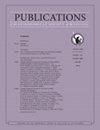Exocomet Models in Transit: Light Curve Morphology in the Optical—Near Infrared Wavelength Range
IF 7.7
3区 物理与天体物理
Q2 ASTRONOMY & ASTROPHYSICS
Publications of the Astronomical Society of the Pacific
Pub Date : 2024-08-01
DOI:10.1088/1538-3873/ad4fe3
引用次数: 0
Abstract
Following the widespread practice of exoplanetary transit simulations, various presumed components of an extrasolar system can be examined in numerically simulated transits, including exomoons, rings around planets, and the deformation of exoplanets. Template signals can then be used to efficiently search for light curve features that mark specific phenomena in the data, and they also provide a basis for feasibility studies of instruments and search programs. In this paper, we present a method for exocomet transit light curve calculations using arbitrary dust distributions in transit. The calculations, spanning four distinct materials (carbon, graphite, pyroxene, and olivine), and multiple dust grain sizes (100–300 nm, 300–1000 nm, and 1000–3000 nm) encompass light curves in VRJHKL bands. We also investigated the behavior of scattering colors. We show that multicolor photometric observations are highly effective tools in the detection and characterization of exocomet transits. They provide information on the dust distribution of the comet (encoded in the light curve shape), while the color information itself can reveal the particle size change and material composition of the transiting material, in relation to the surrounding environment. We also show that the typical cometary tail can result in the wavelength dependence of the transit timing. We demonstrate that multi-wavelength observations can yield compelling evidence for the presence of exocomets in real observations.飞行中的Exocomet模型:光学-近红外波长范围内的光曲线形态学
按照系外行星凌日模拟的普遍做法,可以通过数值模拟凌日来研究太阳系外系统的各种假定组成部分,包括外月、行星周围的星环以及系外行星的变形。模板信号可以用来有效地搜索数据中标记特定现象的光曲线特征,它们也为仪器和搜索程序的可行性研究提供了基础。在本文中,我们介绍了一种利用过境中任意尘埃分布计算外行星过境光曲线的方法。计算涉及四种不同的物质(碳、石墨、辉石和橄榄石)和多种尘埃粒度(100-300 nm、300-1000 nm 和 1000-3000 nm),包括 VRJHKL 波段的光曲线。我们还研究了散射色的行为。我们的研究表明,多色测光观测是探测和描述外行星凌日的非常有效的工具。它们提供了彗星尘埃分布的信息(在光曲线形状中编码),而颜色信息本身则可以揭示出与周围环境相关的凌星物质的粒度变化和物质组成。我们还表明,典型的彗尾会导致凌日时间的波长依赖性。我们证明,在实际观测中,多波长观测可以为外行星的存在提供令人信服的证据。
本文章由计算机程序翻译,如有差异,请以英文原文为准。
求助全文
约1分钟内获得全文
求助全文
来源期刊
CiteScore
6.70
自引率
5.70%
发文量
103
审稿时长
4-8 weeks
期刊介绍:
The Publications of the Astronomical Society of the Pacific (PASP), the technical journal of the Astronomical Society of the Pacific (ASP), has been published regularly since 1889, and is an integral part of the ASP''s mission to advance the science of astronomy and disseminate astronomical information. The journal provides an outlet for astronomical results of a scientific nature and serves to keep readers in touch with current astronomical research. It contains refereed research and instrumentation articles, invited and contributed reviews, tutorials, and dissertation summaries.

 求助内容:
求助内容: 应助结果提醒方式:
应助结果提醒方式:


